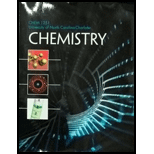
Concept explainers
Lysine, an essential amino acid in the human body, contains
Interpretation:
The empirical and molecular formula of lysine is to be determined with given mass of lysine, mass of carbon dioxide, and mass of water.
Concept introduction:
Empirical formula is the simplest formula of any compound when written in the least possible whole number without altering the relative number of atoms.
The molecular mass of any compound is the sum of the atomic masses of every element that is present in the molecule of the compound. It is denoted by M. The unit of molecular mass isamu.
When any hydrocarbon has completely reacted with oxygen, then the product formed contains
The percent composition of an element by its mass in a compound can be calculated as
Here, n represents the number of atoms in the given molecule or compound.
The number of moles is defined as the ratio of mass to the molar mass:
Here,
The mass of compound can be calculated as
Here,
The molecular formula can be calculated as
Answer to Problem 145AP
Solution:
(a)
(b)
Explanation of Solution
a) The empirical formula of lysine
The molar mass of carbon dioxide is
Calculate the mass of carbon dioxide as
Substitute
The molar mass of hydrogen is
Calculate the mass of water as
Substitute
The molar mass of nitrogen is
Calculate the mass of ammonia as
Substitute
Calculate the mass percent of carbon as
Calculate the mass percent of hydrogen as
Calculate the mass percent of nitrogen as
Calculate the mass percent of oxygen as
Now, calculate the number of moles by assuming the sample to be 100 g.
The molar mass of carbon is
Calculate the number of moles of carbon as
Substitute
The molar mass of hydrogen is
Calculate the number of moles of hydrogen as
Substitute
The molar mass of nitrogen is
Calculate the number of moles of nitrogen as
Substitute
The molar mass of oxygen is
Calculate the number of moles of oxygen as
Substitute
Calculate the ratio of carbon, hydrogen, nitrogen, and oxygen as
Hence, the empirical formula of lysine is
b)The molecular formula of the compound
The molecular mass of lysine is 150 g.
Calculate the empirical formula mass of lysine as
Now, the whole number multiple
Substitute
Calculate the molecular formula as
Substitute 2 for
Hence, themolecular formula of lysine is
Want to see more full solutions like this?
Chapter 3 Solutions
CHEMISTRY >CUSTOM<
- 4.108 Elemental analysis is sometimes carried out by combustion of the sample. For a hydrocarbon, the only products formed are CO2 and H2O. If a 1.36-g sample of an unknown hydrocarbon is burned and 2.21 g of H2O is produced along with 4.07 g of CO2, what is the empirical formula of the hydrocarbon?arrow_forwardYou take 1.00 g of an aspirin tablet (a compound consisting solely of carbon, hydrogen, and oxygen), burn it in air, and collect 2.20 g CO2 and 0.400 g H2O. You know that the molar mass of aspirin is between 170 and 190 g/mol. Reacting 1 mole of salicylic acid with I mole of acetic anhydride (C4H6O3) gives you 1 mole of aspirin and 1 mole of acetic acid (C2H4O2). Use this information to determine the molecular formula of salicylic acid.arrow_forward4.69 The pictures below show a molecular-scale view of a chemical reaction between H2 and CO to produce methanol, CH3OH. The box on the left represents the reactants at the instant of mixing, and the box on the right shows what is left once the reaction has gone to completion. Was there a limiting reactant in this reaction? If so, what was it? Write a balanced chemical equation for this reaction. As usual, your equation should use the smallest possible whole number coefficients for all substances.arrow_forward
- Tungsten (W) metal, which is used to make incandescent bulb filaments, is produced by the reaction WO3+3H23H2O+W How many grams of H2 are needed to produce 1.00 g of W?arrow_forwardYou perform a combustion analysis on a 255 mg sample of a substance that contains only C, H, and O, and you find that 561 mg CO2 is produced, along with 306 mg H2O. a If the substance contains only C, H, and O, what is the empirical formula? b If the molar mass of the compound is 180 g/mol, what is the molecular formula of the compound?arrow_forwardNitrogen fixation in the root nodules of peas and other legumes occurs with a reaction involving a molybdenum-containing enzyme named nitrogenase. This enzyme contains two Mo atoms per molecule and is 0.0872% Mo by mass. Calculate the molar mass of the enzyme.arrow_forward
 General Chemistry - Standalone book (MindTap Cour...ChemistryISBN:9781305580343Author:Steven D. Gammon, Ebbing, Darrell Ebbing, Steven D., Darrell; Gammon, Darrell Ebbing; Steven D. Gammon, Darrell D.; Gammon, Ebbing; Steven D. Gammon; DarrellPublisher:Cengage Learning
General Chemistry - Standalone book (MindTap Cour...ChemistryISBN:9781305580343Author:Steven D. Gammon, Ebbing, Darrell Ebbing, Steven D., Darrell; Gammon, Darrell Ebbing; Steven D. Gammon, Darrell D.; Gammon, Ebbing; Steven D. Gammon; DarrellPublisher:Cengage Learning Chemistry for Engineering StudentsChemistryISBN:9781337398909Author:Lawrence S. Brown, Tom HolmePublisher:Cengage Learning
Chemistry for Engineering StudentsChemistryISBN:9781337398909Author:Lawrence S. Brown, Tom HolmePublisher:Cengage Learning Chemistry: Principles and PracticeChemistryISBN:9780534420123Author:Daniel L. Reger, Scott R. Goode, David W. Ball, Edward MercerPublisher:Cengage Learning
Chemistry: Principles and PracticeChemistryISBN:9780534420123Author:Daniel L. Reger, Scott R. Goode, David W. Ball, Edward MercerPublisher:Cengage Learning Chemistry: An Atoms First ApproachChemistryISBN:9781305079243Author:Steven S. Zumdahl, Susan A. ZumdahlPublisher:Cengage Learning
Chemistry: An Atoms First ApproachChemistryISBN:9781305079243Author:Steven S. Zumdahl, Susan A. ZumdahlPublisher:Cengage Learning
 ChemistryChemistryISBN:9781305957404Author:Steven S. Zumdahl, Susan A. Zumdahl, Donald J. DeCostePublisher:Cengage Learning
ChemistryChemistryISBN:9781305957404Author:Steven S. Zumdahl, Susan A. Zumdahl, Donald J. DeCostePublisher:Cengage Learning





